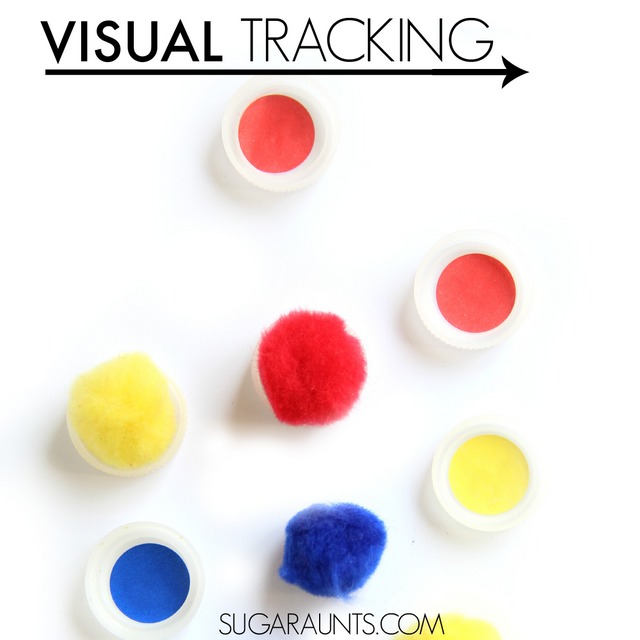Here we are covering all things visual tracking, including what visual tracking means, how to improve visual tracking skills, and visual tracking toys to support development of this visual processing skill.
Amazon affiliate links are included in this blog post. As an Amazon Influencer, I earn from qualifying purchases.
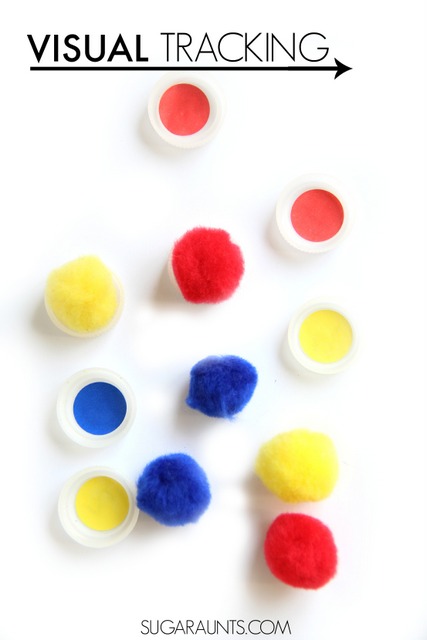
What is Visual Tracking
Visual tracking is typically defined as the ability to efficiently move the eyes from left to right (or right to left, up and down, and circular motions) OR focusing on an object as it moves across a person’s visual field.
This skill is important for almost all daily activities, including reading, writing, cutting with scissors, drawing, and playing. According to typical development of visual processing, the ability to visually track objects emerges in children around the age of five.
Reading a paragraph without losing their place, copying a list of homework from the chalkboard, misalignment of vertical and horizontal numbers in math problems, confusion in interpreting written direction, mixing up left/right, persistent letter reversals…Does any of this sound familiar? It’s all visual tracking!
Vision and visual tracking are tasks that happen without us even realizing. The brain and it’s jobs is an amazing thing and our eyes are moving, tracking, scanning, focusing, pursuing, and accommodating without us even realizing. There are many ways to work on visual perception in playful and creative ways.
Related is the visual figure ground piece, which allows us to pull visual information from a busy background, and track that visual input.
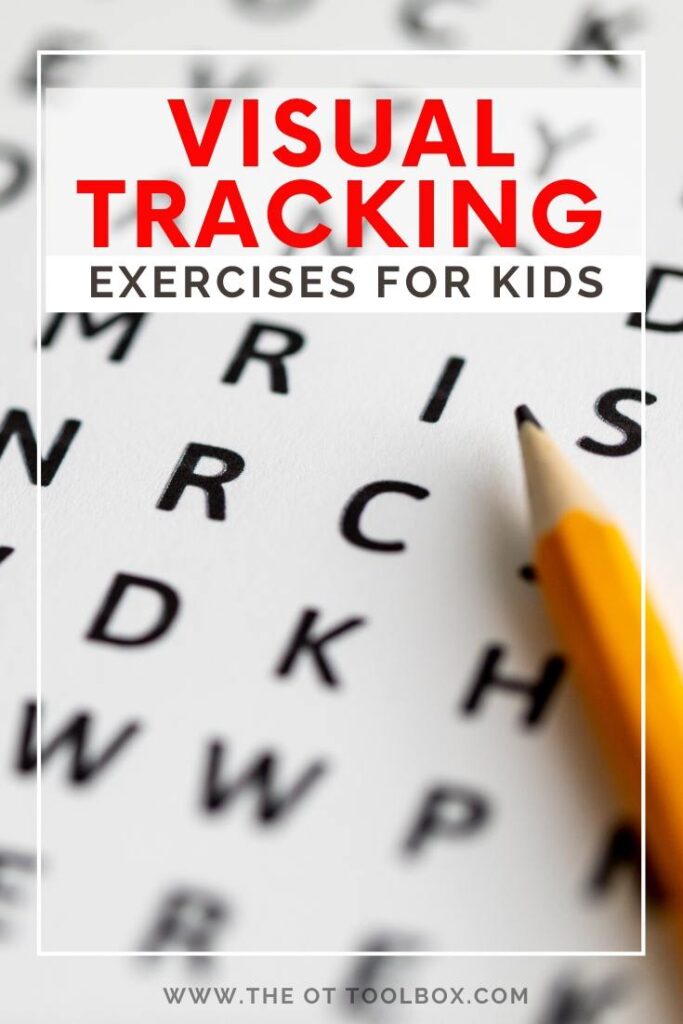
Visual Tracking Exercises
Using visual tracking exercises like the one described below can be a powerful way to use eye exercises to improve vision in kids. These are the visual skills needed not for visual acuity, but rather, those unseen visual problems that impact visual processing skills.
Visual tracking exercises can include vision therapy activities that improve areas such as visual saccades or smooth visual pursuit.
Difficulties in Visual Tracking
You might see problems with these tasks if a child has difficulty with visual tracking:
- Losing place when reading. Re-reads or skips words or lines.
- Omits, substitutes, repeats, or confuses similar words when reading.
- Must use finger to keep place when reading.
- Poor reading comprehension.
- Short attention span.
- Difficulty comprehending or remembering what is read.
- Confusion with interpreting or following written directions.
- Writing on a slant, up or down hill, spacing letters and words irregularly.
- Confusion with left/right directions.
- Persistent reversals of letters (b, d, p, q) when naming letters.
- Reverses letters when writing (persistent reversals after 2nd grade.)
- Errors when copying from a chalkboard or book to paper.
- Misalignment of horizontal and vertical series’ of numbers in math problems.
Also related to visual tracking and very similar while being involved in many of these problem areas, is visual scanning.
It is important to note that not all of these difficulties indicate a true visual tracking and or visual scanning problem. For example, many children demonstrate poor reading comprehension and may show a short attention span while not having visual scanning problems.
All children should be evaluated by a pediatric physician, behavioral optometrist, and occupational therapist to determine true visual processing and visual tracking or visual scanning deficits. These recommendations are meant to be a resource.
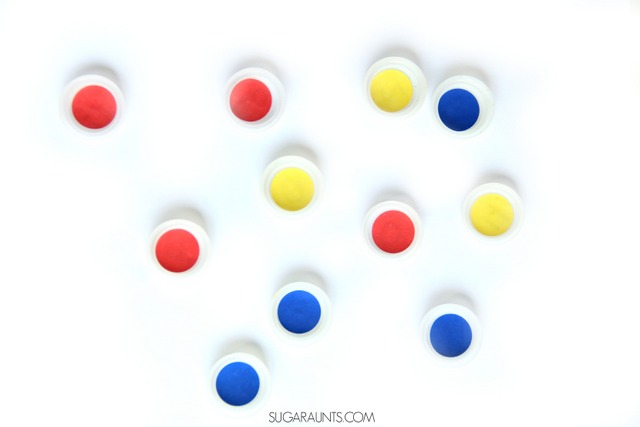
Visual Tracking Activities
Today, I’m sharing an easy visual tracking activity that will help kids with many functional difficulties. This post is part of our new series where we are sharing 31 days of Occupational Therapy using mostly free or inexpensive materials.
Today’s activity should cost you at most $2 unless you already have these items in your craft cupboard or office supplies. Add this activity to your treatment bag for multiple activities. Read on:
Amazon affiliate links below.
This Visual tracking activity is easy to set up. Gather recycled bottle caps. I used round dot labels (affiliate link) from our office supplies to color the inside of each cap. You could also use a marker or paint to color the bottle caps. Use what you’ve got on hand to make this treatment activity free or almost free! Next, gather matching crafting pom poms. (affiliate link) These can be found at the dollar store for and inexpensive treatment item.
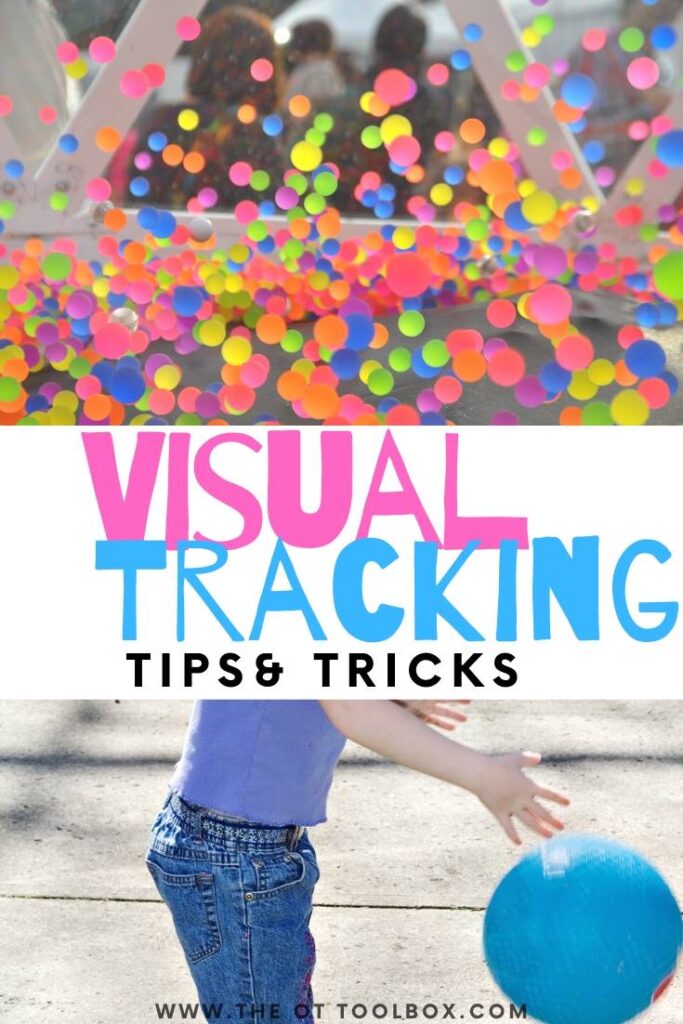
Skills Related to Visual Tracking
It’s important to mention that there are several skills related to visual tracking. These sub-areas should be identified as a piece of the overall puzzle. Areas related to visual tracking play a role in the eyes ability to fixate on an object and follow it as it moves. These skills include:
- Visual fixation
- Peripheral tracking
- Visual pursuit
Visual Fixation Activity: (Maintaining vision on an item in the visual field) Work one eye at a time.
- Have your child close one eye and place a colored crafting pom pom onto a matching bottle cap. They need to use one hand to place the pom pom into the corresponding bottle cap and not move bottle caps around on the table.
- After the child has filled all of the bottle caps using one eye, repeat the task with the other eye.
- Then complete the activity using both eyes.
- You can also do this activity by placing the label dots on a paper. Match the bottle caps onto the dots.
Visual Stare Activity (the amount of time the eyes can fixate on an object without eye movements)
- Hold up one bottle cap on your nose.
- Ask your child to sit about 18 inches from you and stare at the bottle cap. Note their eye movements as they stare.
- Keep track of time that the child can stare at the target without visual saccades (eye movements).
Peripheral Tracking Activity (visually tracking from the peripheral visual fields)
- Arrange the bottle caps on the table.
- Place a pom pom in the center of the table, with the bottle caps all around it.
- Ask your child to stare at the pom pom. While keeping their head still and only moving their eyes, ask them to quickly find a bottle cap with the same color.
- Ask them to scan to another bottle cap of the same color until they’ve found all of the caps with that color.
- You can add a level to this task by writing letters or numbers in the bottle caps and asking the child to find letters in order or numbers in order.
Visual Tracking Pursuit Activity (watching and tracking a moving object)
- Set one bottle cap on the right side of the table.
- Place another at the left side.
- The adult should blow a crafting pom pom from the right to the left and ask the child to follow the pom with his eyes, without moving their head.
- Repeat by blowing the pom pom from the left to the right, front to back, and back to front in front of the child.
Visual Tracking Tracing Lines (Watching a pencil line as it is formed, and following the line with eye-hand coordination to trace with a pencil or marker)
- Set one vertical row of bottle cap on the left side of the child.
- Place another vertical row on the right side.
- The adult should draw a line from one bottle cap on the left side to a matching bottle cap on the right side.
- Instruct the child to follow the pencil as you draw. Nest, trace the line with your finger.
- Ask the child to trace the line with their finger.
- They can then trace the lines with a pencil or marker.
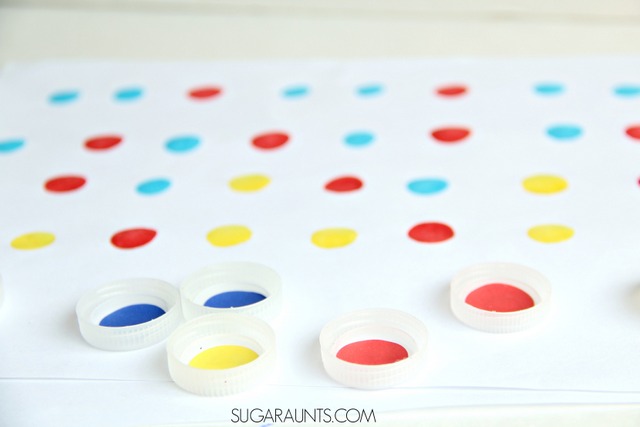
More eye tracking Strategies
- Complete mazes
- Do puzzles.
- Use a newspaper or magazine article. Ask your child to highlight all of the letter “a’s”.
- Draw or paint pictures.
- Place a marble in a pie pan. Rotate the pan around and watch the ball as it rolls. Don’t move your head, only your eyes!
- Find as many things shaped like a a square in the room. Repeat the activity, finding all of the circular shaped items in the room.
- Play “I Spy.”
- Dot-to-dot pictures.
- Play balloon toss.
- Use tracing paper to trace and color pictures.
- Trace letters with chalk.
- Play flashlight tag on walls and ceilings. The adult an child each holds a flashlight. As the adult shines the light on walls, the child keeps their light superimposed on top of yours. Start with simple strait lines. Then add curved lines, then a circle. Tell them what you are drawing next. Advance the activity by drawing shapes without telling them what you are doing next.
- Play with wind-up cars.
- Create a race track on the floor. Follow cars with your eyes.
- Roll a ball between you and the child. Roll from left-right, right-left, front-back, back-front, and toss the ball.
![]()
Visual tracking Toys
Looking for more tools to improve visual tracking? The toys below are great for improving visual tracking and visual scanning in fun ways. These toys, games, and ideas may be a great gift idea for little ones who have visual perceptual difficulties or problems with visual tracking and handwriting, body awareness in space, letter reversals, detail awareness, or maintaining place while reading.
SO, save these ideas for grandparents and friends who might ask for gift ideas for birthdays and holidays. These are some powerhouse visual tracking ideas!
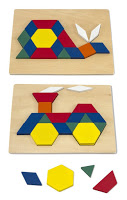
Use Pattern Blocks and Boards (affiliate link) to work on visual fixation of shapes and sizes of shapes.
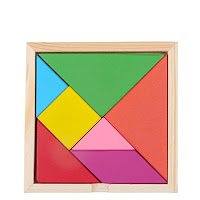
This Wooden Tangram Puzzle (affiliate link) has many different shapes and forms that can be copied from instructions. Copying from a diagram is a great way to practice visual tracking.
For younger kids, this Wooden Stacking Toy encourages tracking for color sorting. Try some of our pom pom activities that we discussed above!
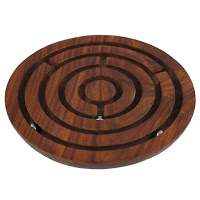
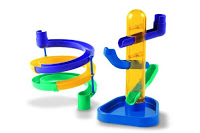
Mazes are excellent for fostering and building on visual tracking skills. Particularly those that involve a moving ball such as a Marble Run (affiliate link)
or a labrynth (affiliate link).
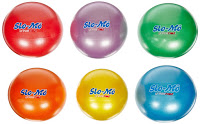
Watching a ball or moving object that is thrown around a room (like a balloon) is a great way to work on tracking in a big area. These Sportime Sensory Balls SloMo Balls (affiliate link) are lightweight and move more slowly than a typical ball, allowing kids to visually track the bright color. These are very cool for games of toss and rolling in all planes and directions. Use them to address peripheral tracking as well.
A flashlight can be used in so many visual tracking activities. Shine the light on words or letters taped to walls. Play “I Spy” in a dark room, shine shapes like this flashlight (affiliate link)can for visual tracking and form tracking.
More visual Tracking Toys
These visual tracking toys are Amazon affiliate links.
- Liquid Motion Bubbler Pens
- Maze Ball
- Liquid Timer 2 Pack
- Labyrinth Puzzle
- Toddler Car Ramp Toys
- Wooden Ramp Racer
- Clear Rainmaker Toy
- Shuttle Ball Toy (Zoom Ball) Use this tool in therapy zoom ball games.
- Toss and Catch Game
Also check out these other top occupational therapy toys:
- Fine Motor Toys
- Gross Motor Toys
- Pencil Grasp Toys
- Toys for Reluctant Writers
- Toys for Spatial Awareness
- Toys for Visual Tracking
- Toys for Sensory Play
- Bilateral Coordination Toys
- Games for Executive Functioning Skills
- Toys and Tools to Improve Visual Perception
- Toys to Help with Scissors Skills
- Toys for Attention and Focus
Printable List of Toys for VISUAL TRACKING
Want a printable copy of our therapist-recommended toys to support visual tracking skills?
As therapy professionals, we LOVE to recommend therapy toys that build skills! This toy list is done for you so you don’t need to recreate the wheel.
Your therapy caseload will love these VISUAL TRACKING toy recommendations. (There’s space on this handout for you to write in your own toy suggestions, to meet the client’s individual needs, too!)
Enter your email address into the form below. The OT Toolbox Member’s Club Members can access this handout inside the dashboard, under Educational Handouts. Just be sure to log into your account, first!
